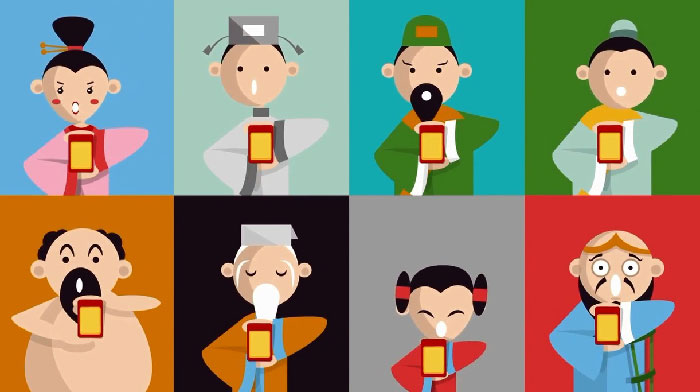On the first day of the Lunar New Year, it is a long-standing tradition for the entire family to gather and pay respects to their ancestors. Children offer their elders well-wishes for the new year, while the elders distribute lucky red envelopes, known as “li xi,” to the children, wishing them prosperity and good fortune. This custom is an integral part of the Vietnamese Tet holiday celebrations.
1 The Origin of the Red Envelope
The tradition of giving lucky money during Tet has its roots in ancient China, and there are numerous stories explaining the emergence of these red envelopes. However, the most popular one involves a demon who liked to pat children’s heads.
Legend has it that in ancient times, there lived a demon named “Sui” in China. Sui had a particular fondness for patting the heads of children, and it would often appear on New Year’s Eve when children were fast asleep. Sui would sneak up on them and pat their heads, causing the children to wake up screaming and sometimes even developing a high fever or becoming foolish.
To protect their children, parents would stay up all night on New Year’s Eve, keeping the lights on and guarding their little ones. This tradition of staying up on New Year’s Eve also stems from this story.

The story goes that there was a family who, after 50 years, finally welcomed a healthy baby boy into their lives. Naturally, the child was doted on by the entire family. One New Year’s Eve, as the child slept, eight fairies happened to pass by and noticed Sui approaching the boy with malicious intent.
Recognizing the goodness in the child’s parents, the fairies decided to intervene. They transformed themselves into eight coins and instructed the parents to wrap the coins in a red packet and place it next to the sleeping boy.

As Sui drew near, the red packets containing the coins emitted a brilliant light, repelling the demon and causing it to flee. Word of this miracle spread, and soon, every household began wrapping coins in red packets and giving them to their children on New Year’s Eve to ward off evil spirits. Thus, the tradition of giving lucky money during Tet was born.
While the red envelope is a familiar concept in Asian cultures, did you know what it’s called in English? Read on to find out!
The term for a red envelope in English is “red envelope,” and the money inside is called “lucky money.”

2 The Significance of the Red Envelope
“Li xi” in Chinese translates to “benefit” or “profit,” implying that the money brings good fortune, blessings, and luck to the recipient, especially children, at the start of a new year.
 The Significance of the Red Envelope
The Significance of the Red Envelope
Today, the custom of giving lucky money during Tet is prevalent in many Asian countries, including China, Vietnam, and Japan. Exchanging these red envelopes is a way to wish one another good health, prosperity, and success in the coming year. Both the giver and the recipient of the red envelopes are believed to attract good fortune and blessings.
The significance of the red envelope lies not in the amount of money but in the sincerity and goodwill behind the gesture. The amount of lucky money is usually small and can include both even and odd amounts.
The red envelope also symbolizes discretion, as it is considered impolite for the recipient to open the envelope in the presence of the giver. This avoids any potential envy or resentment.
For reference: Consider giving amounts that end with even numbers, such as 50k, 100k, or 500k.
3 Modern Li Xi Traditions in Vietnam
During Tet, it is customary for Vietnamese families to gather together on New Year’s Eve or the first day of the new year. They offer incense to their ancestors and celebrate with feasts and well-wishes for the coming year.
This is also the time when younger family members offer their respects and best wishes to their elders and receive lucky red envelopes in return. The money inside the red envelopes is a token of the elders’ wishes for the children’s good health, success in their studies or careers, and overall well-being.
 Modern Li Xi Traditions in Vietnam
Modern Li Xi Traditions in Vietnam
Nowadays, the tradition of giving lucky money is not limited to just the first day of the new year or the first three days, as it was in the past. As long as the festive atmosphere of Tet persists, people can still give li xi to their children and grandchildren.
Additionally, the custom is no longer restricted to elders giving money to children. Working adults can also give li xi to their elders, such as their parents and grandparents, as a way of showing respect and wishing them good health. Furthermore, the tradition has expanded beyond family ties, and it is now common for friends, colleagues, and even neighbors to exchange lucky money during Tet greetings.
A word of caution: Be mindful of certain taboos during Tet to avoid bad luck.
4 How Much Li Xi is Appropriate?
Over time, the original meaning of the red envelope has somewhat faded, and people have started to focus more on the monetary value of the gift. Questions like “How much li xi is enough?” have become common, shifting the emphasis from the spiritual significance to material considerations.
 How Much Li Xi is Appropriate?
How Much Li Xi is Appropriate?
In the past, Vietnamese people typically placed 500 VND or 10,000 VND bills in the red envelopes, as both denominations were red and symbolized wishes for health, luck, and peace for the recipients. Nowadays, the amount of money in the red envelopes varies depending on the relationship and status of the giver and recipient. For instance, when giving li xi to parents, it is customary to offer a higher amount to express gratitude and wish them abundant health.
Regardless of the amount, the red envelope continues to embody the givers’ hopes for the recipients’ good health and fortune in the coming year.
Today, red envelopes come in various designs and colors beyond the traditional red and gold, catering to the diverse tastes and preferences of individuals.
Red envelopes foster connections and serve as a means to convey warm wishes for a prosperous and peaceful new year. While the way Tet is celebrated has evolved over time, the tradition of giving lucky money remains a beautiful and integral part of Vietnam’s cultural heritage.






































